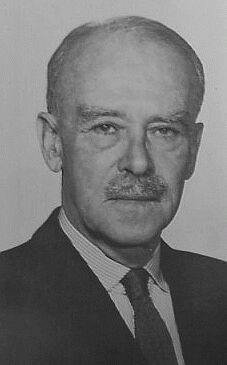Richard Casey, Baron Casey
|
|
Richard Gardiner Casey, Baron Casey (29 August 1890 - 17 June 1976), Australian politician and diplomat and 16th Governor-General of Australia, was born in Brisbane, Queensland. His father, also named Richard Gardiner Casey was a wealthy pastoralist and Queensland state politician of Irish descent. His mother, Evelyn, was the daughter of George Harris, another wealthy pastoralist and Queensland state politician. He was educated at an exclusive private school in Melbourne, at the University of Melbourne, where he gained an engineering degree, and at Cambridge, where he completed a Master of Arts. In 1914 he joined the Australian Army, and served at Gallipoli and in France, winning the Military Cross.
After the war Casey worked for engineering and mining firms until 1924, when Prime Minister Stanley Bruce appointed him his political liaison officer in London, a position he held until 1931, sending home confidential reports on political and economic matters, both for Bruce and for his Labor successor, James Scullin. In 1926 he married Maie Ryan, with whom he had two children.
In 1931 Casey returned to Australia and was elected to the House of Representatives as United Australia Party MP for the Geelong-based seat of Corio. Prime Minister Joseph Lyons appointed him an assistant minister in 1933, and in 1935 he became Treasurer (finance minister). In 1939 Robert Menzies became Prime Minister for the first time. He saw Casey as a rival, and moved him to the lesser portfolio of Development.
In 1940 Menzies appointed Casey as the first Australian Ambassador to the United States. This was a vital posting in wartime, but it also served to get Casey out of domestic politics. Casey was in Washington when the United States entered the war, and played an important role in establishing the alliance between the United States and Australia.
Ac.casey2.jpg
Casey moved to Cairo in 1942 when Winston Churchill appointed him Minister Resident in the Middle East. In this role he played a key role in negotiating between the British and Allied governments, local leaders and the Allied commanders in the field. In 1944, when the Middle East ceased to be a military theatre, Casey was appointed Governor of Bengal, a post he held until 1946.He was felt to be a success in this role. An unusual friendship during this period was with the war hero, Lieutanant General Sir Adrian Carton De Wiart, Churchill's representative to China.
In 1946 Casey returned to Australia, and became Federal President of the Liberal Party, the new party Menzies had formed in 1944 as part of his reorganisation of conservative politics in Australia. Although Menzies still saw Casey as a rival, and although Casey undoubtedly saw himself as a future Prime Minister, they formed an effective partnership.
The Liberals won the 1949 elections, and Casey returned to the House of Representatives as MP for a Melbourne seat. Menzies appointed him Minister for Supply and Development. In 1951, when the Minister for External Affairs, Percy Spender (another Menzies rival), was dispatched to the Washington embassy, Casey succeeded him. Casey held the External Affairs post during the height of the Cold War, the Suez Crisis, the war in Indo-China and other major world events. He formed close relations with Anthony Eden, John Foster Dulles and other leaders.
Casey retired in 1960, and was created "Baron Casey, of Berwick in the State of Victoria and the Commonwealth of Australia, and of the City of Westminister", becoming the third and last Australian politician (after Sir John Forrest and Stanley Bruce) to be elevated to the House of Lords. In 1965 Menzies appointed him Governor-General - the first time a conservative Prime Minister had appointed an Australian to the post.
One of the arguments against appointing an Australian, particularly a former politician, as Governor-General had always been that they would be too closely involved with Australian personalities and issues to perform their constitutional role impartially. This became an acute issue for Casey in December 1967, when Prime Minister Harold Holt died.
Casey could have commissioned the Deputy Leader of the Liberal Party, William McMahon, as acting Prime Minister, but instead he commissioned John McEwen, the leader of Liberals' coalition partner, the Country Party. It was later alleged that Casey did this in order to prevent McMahon having an advantage in the Liberal Party's ballot for a new leader, since he shared the view of some Liberals that McMahon would not be a suitable successor.
This matter was aired in a 1969 book, The Power Struggle, by veteran political journalist Alan Reid. Casey's biographer, W J Hudson says (in his 1986 book Casey) that Casey was concerned to preserve the Liberal-Country Party coalition, and that he knew (because McEwen told him) that the Country Party would not serve under McMahon. If this was his motive for commissioning McEwen rather than McMahon, it suggests that he did take political considerations into account in making his decision.
Casey left office in 1969 and he and his wife retired to their farm at Berwick in Victoria. Casey never fully recovered from a car accident in 1974, and died in June 1976. The municipality which includes Berwick is now called the City of Casey (http://www.casey.vic.gov.au).
Further reading
- R G Casey, Australian Foreign Minister, Collins 1972
- R G Casey, Personal Experience, Comstable 1962
- W J Hudson, Casey, Oxford University Press 1986
- Alan Reid, The Power Struggle, Tartan Press 1969
| Preceded by: Joseph Lyons | Treasurer of Australia 1935–1940 | Succeeded by: Robert Menzies |
| Preceded by: Oliver Lyttelton | Minister Resident in the Middle East 1942–1944 | Succeeded by: The Lord Moyne (Minister of State) |
| Preceded by: Percy Spender | Foreign Minister of Australia 1951–1960 | Succeeded by: Robert Menzies |
| Preceded by: The Viscount De L'Isle | Governor-General of Australia 1965–1969 | Succeeded by: Sir Paul Hasluck |

